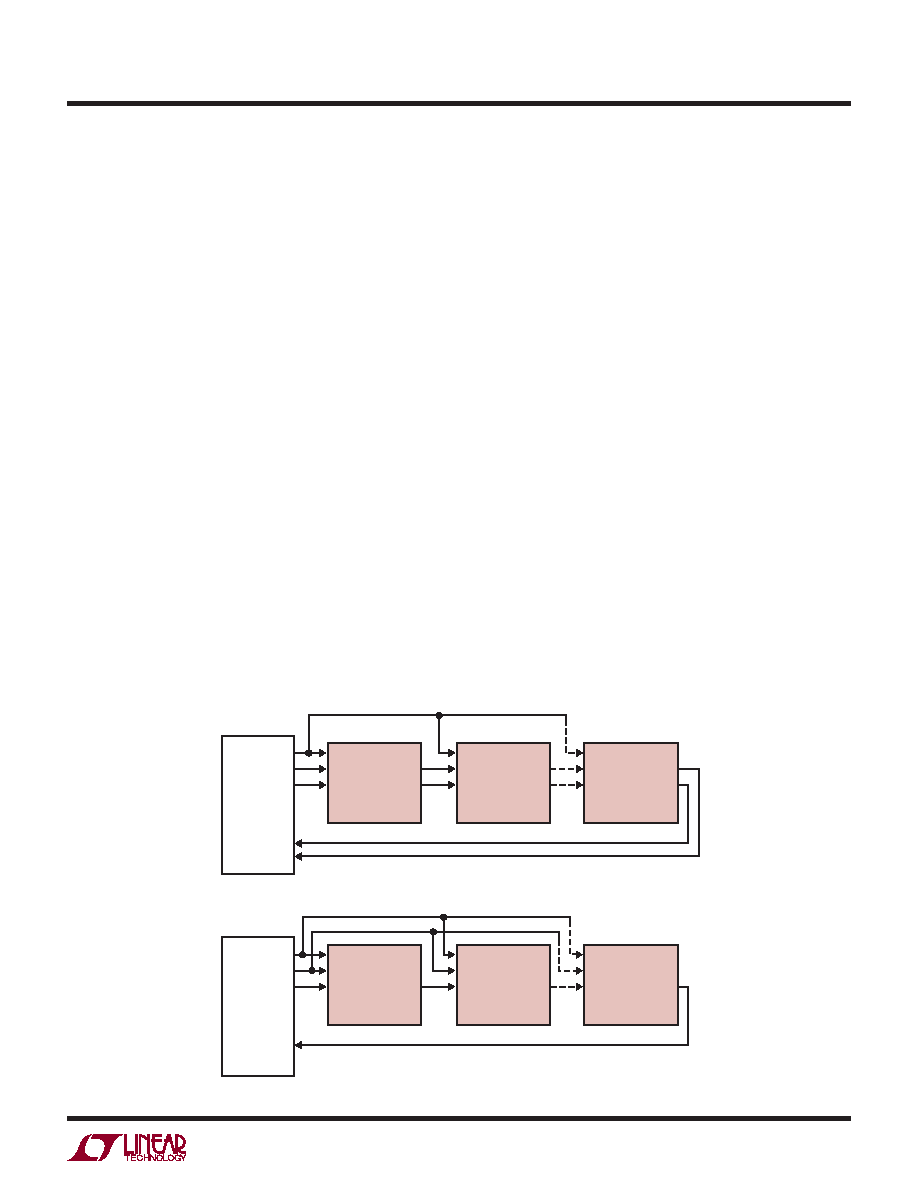- 您现在的位置:买卖IC网 > Sheet目录2002 > LT8500IUHH#TRPBF (Linear Technology)IC PWM GENERATOR 56-QFN

LT8500
9
8500f
operaTion
START-UP
The LT8500 is ready to communicate after power-up, if
the LDIBLANK pin is low. The PWM[48:1] outputs remain
disabled (logic 0) until an output enable frame is sent. The
recommended sequence of events for start-up is:
1. Apply power and drive LDIBLANK low. SDO will go low
when the on-chip power-on-reset (POR) de-asserts.
2. Send a correction register frame (CMD = 0x20) on the
serial interface. This sets the correction factor on each
channel.
3. Send an update frame (CMD = 0x00 or CMD = 0x10)
on the serial interface. This sets the pulse width of each
channel.
4. Send an output enable frame (CMD = 0x30) on the
serial interface. This enables the modulated pulses on
the PWM[48:1] outputs.
The PWM clock (PWMCK) should be turned on before
step 4. The start of a PWM period, when all PWM[48:1]
channels turn on, is synchronized to the output enable
frame when the outputs are disabled prior to the frame.
Figure 2. Serial Interface Topologies
SERIAL DATA INTERFACE
The LT8500 has a 50MHz cascadable serial data interface
with full buffering and skew balancing on clock and data.
The interface uses a novel 5-wire (LDIBLANK, SCKI, SDI,
SCKO, and SDO) topology and can be connected to a
variety of digital controllers, such as microcontrollers,
digital signal processors (DSPs), or field programmable
gate arrays (FPGAs).
Topology
Two topologies shown in Figure 2 are supported for cas-
cading the LT8500. For higher speeds and a large number
of LT8500s, consider the novel 5-wire topology. For lower
speedsandfewLT8500s,considertheconventional4-wire
topology. Whichever topology is used, signal integrity
should be carefully evaluated, especially for the clocks.
The 5-wire topology eliminates the need for global SCKI
routing and reduces the need for buffer insertion for the
SCKI signal. Instead, it provides the SCKO signal along
with the SDO signal to drive the next chip. The skew inside
the chip between the SCKI and SDI signals is balanced
internally. The skew outside the chip between the SCKO
and SDO signals can be easily balanced by parallel routing
8500 F02
LDI
SCKI
SDI
SCK0
SDO
HOST
CONTROLLER
LDI
SCKI
SDI
SDO
SCKO
LT8500 (1)
LDI
SCKI
SDI
SCK0
SDO
LT8500 (2)
LDI
SCKI
SDI
SCK0
SDO
LT8500 (N)
LDI
SCKI
SDI
SDO
HOST
CONTROLLER
Conventional 4-Wire Topology
Novel 5-Wire Topology
LDI
SCKI
SDI
SDO
LT8500 (1)
LDI
SCKI
SDI
SDO
LT8500 (2)
LDI
SCKI
SDI
SDO
LT8500 (N)
发布紧急采购,3分钟左右您将得到回复。
相关PDF资料
LTC1096IN8#PBF
IC A/D CONV 8BIT SRL IN/OUT 8DIP
LTC1099ACN#PBF
IC A/D CONV 8BIT HI-SPEED 20-DIP
LTC1197IMS8#PBF
IC ADC 10BIT 500KHZ SHTDWN 8MSOP
LTC1198-1BCS8#PBF
IC ADC 8BIT 750KHZ SAMPL 8-SOIC
LTC1257IS8#TRPBF
IC D/A CONV 12BIT VOLT OUT 8SOIC
LTC1276ACN#PBF
IC A/D CONV 12BIT SAMPLING 24DIP
LTC1278-4IN#PBF
IC A/DCONV SAMPLNG W/SHTDN 24DIP
LTC1279CG#TRPBF
IC A/DCONV SAMPLNG W/SHTDN24SSOP
相关代理商/技术参数
LT-8501M
制造商:Mencom 功能描述:
LT8582EDKD#PBF
功能描述:IC REG MULTI CONFIG ADJ 3A 24DFN RoHS:是 类别:集成电路 (IC) >> PMIC - 稳压器 - DC DC 开关稳压器 系列:- 标准包装:250 系列:- 类型:降压(降压) 输出类型:固定 输出数:1 输出电压:1.2V 输入电压:2.05 V ~ 6 V PWM 型:电压模式 频率 - 开关:2MHz 电流 - 输出:500mA 同步整流器:是 工作温度:-40°C ~ 85°C 安装类型:表面贴装 封装/外壳:6-UFDFN 包装:带卷 (TR) 供应商设备封装:6-SON(1.45x1) 产品目录页面:1032 (CN2011-ZH PDF) 其它名称:296-25628-2
LT8582EDKD#PBF
制造商:Linear Technology 功能描述:DC/DC CONVRTER BOOST INVERTING SEPIC
LT8582EDKD#TRPBF
功能描述:IC REG MULTI CONFIG ADJ 3A 24DFN RoHS:是 类别:集成电路 (IC) >> PMIC - 稳压器 - DC DC 开关稳压器 系列:- 设计资源:Design Support Tool 标准包装:1 系列:- 类型:升压(升压) 输出类型:固定 输出数:1 输出电压:3V 输入电压:0.75 V ~ 2 V PWM 型:- 频率 - 开关:- 电流 - 输出:100mA 同步整流器:是 工作温度:-40°C ~ 85°C 安装类型:表面贴装 封装/外壳:SOT-23-5 细型,TSOT-23-5 包装:剪切带 (CT) 供应商设备封装:TSOT-23-5 其它名称:AS1323-BTTT-30CT
LT8582IDKD#PBF
功能描述:IC REG MULTI CONFIG ADJ 3A 24DFN RoHS:是 类别:集成电路 (IC) >> PMIC - 稳压器 - DC DC 开关稳压器 系列:- 标准包装:250 系列:- 类型:降压(降压) 输出类型:固定 输出数:1 输出电压:1.2V 输入电压:2.05 V ~ 6 V PWM 型:电压模式 频率 - 开关:2MHz 电流 - 输出:500mA 同步整流器:是 工作温度:-40°C ~ 85°C 安装类型:表面贴装 封装/外壳:6-UFDFN 包装:带卷 (TR) 供应商设备封装:6-SON(1.45x1) 产品目录页面:1032 (CN2011-ZH PDF) 其它名称:296-25628-2
LT8582IDKD#PBF
制造商:Linear Technology 功能描述:DC/DC CONVRTER BOOST INVERTING SEPIC
LT8582IDKD#TRPBF
功能描述:IC REG MULTI CONFIG ADJ 3A 24DFN RoHS:是 类别:集成电路 (IC) >> PMIC - 稳压器 - DC DC 开关稳压器 系列:- 设计资源:Design Support Tool 标准包装:1 系列:- 类型:升压(升压) 输出类型:固定 输出数:1 输出电压:3V 输入电压:0.75 V ~ 2 V PWM 型:- 频率 - 开关:- 电流 - 输出:100mA 同步整流器:是 工作温度:-40°C ~ 85°C 安装类型:表面贴装 封装/外壳:SOT-23-5 细型,TSOT-23-5 包装:剪切带 (CT) 供应商设备封装:TSOT-23-5 其它名称:AS1323-BTTT-30CT
LT8584IFE#PBF
制造商:Linear Technology 功能描述:IC BATT CELL BALANCE 16TSSOP 制造商:Linear Technology 功能描述:BATTERY BALANCER, 2.5V-5.3V, TSSOP-16, Supply Voltage Min:2.5V, Supply Voltage M